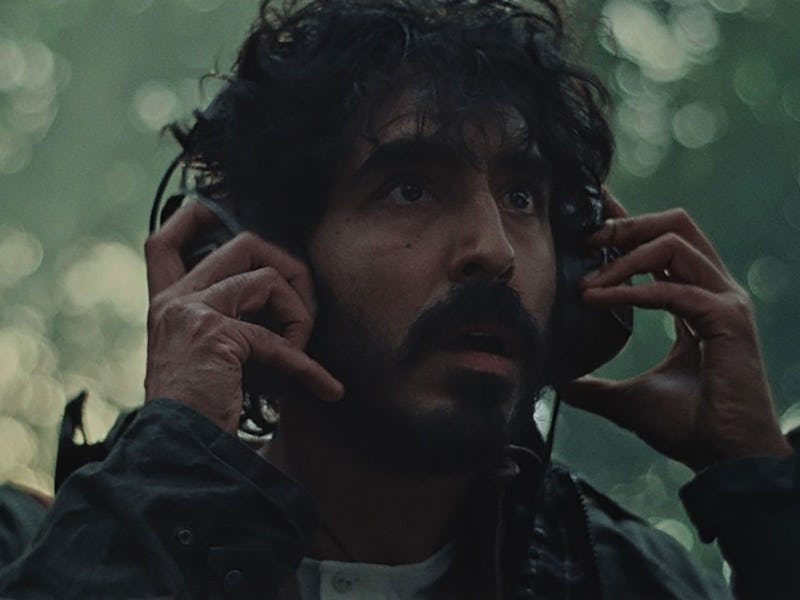Rabbit Trap Is An Atmospheric Folk Horror That Fails To Deliver On A Creepy Premise
Dev Patel stars in the atmospheric horror film without much atmosphere or horror.

In the ‘70s, a pseudoscientific idea called the Stone Tape theory started to gain popularity in the U.K. It was a theory that rocks and other inanimate objects can retain spiritual energy or trauma — like a tape. In other words, rocks might be haunted. It’s an intriguing idea, especially when you think about the thousands of old, creepy stone cottages that dot the British countryside, and the centuries of history and ghosts that they likely carry in their foundations. And it’s an idea that Rabbit Trap, writer-director Bryn Chainey’s new folk horror film starring Dev Patel, attempts to unpack, before taking a hard left turn into a baffling new genre.
Rabbit Trap opens with a strange image: a monitor with an audio waveform that moves and dilates with a woman’s hypnotic voice. Suddenly the voice distorts, and the waveform explodes into a series of kaleidoscopic images that move and twirl and seem … alive. It’s a tantalizing omen of things to come, which is immediately followed up by another intriguing scene: Darcy (Dev Patel) is recording the ambient sounds around the Welsh countryside cottage that he and his wife Daphne (Rosy McEwen) have just moved into. He has his microphone trained on a bird murmuration overhead, and the sound of the swooping, rustling birds is magnified through his headphones. We follow him as he records other such mundane things — the trickling of a creek, the rustling of grass, the squelching mud underfoot. But suddenly, he hears a strange, echoing noise emanating from the woods. Is it a voice? An old song recording? A radio frequency he’s somehow hacked? Either way, he follows the strange song of overlapping voices and haunting singing, which takes him straight to a fairy ring in the middle of a clearing. As he walks closer to the strange ring of mushrooms, the sounds get louder and louder, until it’s almost deafening. Then, as he steps into the ring, the sound suddenly cuts off — and Darcy passes out.
These opening moments of Rabbit Trap, Chainey’s feature directorial debut, provocatively tease a very different, much better, film than what it ends up becoming. Aided by sound designer Graham Reznick, Chainey begins to craft an atmospheric soundscape that pokes at the border between this world and a dark, mysterious otherworld steeped in Welsh folklore. The reason that Darcy is recording these sounds helps build the tension with these dangerous, supernatural forces: Daphne is a recording artist who turns his ambient sounds into surreal music. When she hears the sound that he’s captured from the fairy ring, she’s ecstatic — this is just the sound she was looking for, for her latest track. But as she cranks up the sound, Darcy starts to act more uneasy, and his mood passes onto Daphne until they both seem possessed by some mystic force. Things only get weirder from there, when Darcy spots a small figure of a boy watching their house from afar. It’s then that the film’s delicate balance between folk horror and fairy tale gets completely obliterated.
The Child (a chilling Jade Croot) isn’t necessarily the worst part of Rabbit Trap, but he is the thing that murders its most intriguing elements stone-dead. Once the Child enters Darcy and Daphne’s lives, appearing like a classic changeling that exists to tempt them to the dark otherworld, Rabbit Trap’s focus switches — no longer is it a dread-filled cosmic horror, it’s now a folksy fairy tale. And the latter feels in direct opposition to the atmospheric soundscape that Chainey was building in the film’s first half, making Rabbit Trap feel like two films warring with each other.
Patel and McEwan do their best, but start to feel lost when the film takes a turn for the more whimsical. And Croot seems stuck between both films — her physical similarity to Barry Keoghan (which the movie plays up a lot) drives a lot of the creepiness in her performance, continuing the first half’s sense of eerie horror. But everything the Child does is straight out of the folktale handbook, rendering his actions less threatening, and more fanciful. Chainey unwisely also begins to phase out the film’s auditory focus, turning Rabbit Trap into a more by-the-book heightened fairy tale.
In the end, Rabbit Trap feels like a movie caught by its own ambitions — an intriguing premise that then gets lost down random narrative and tonal tangents. It’s a shame to see what could’ve been a truly unique and singular movie fall so far down the rabbit hole.